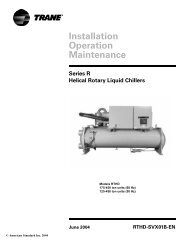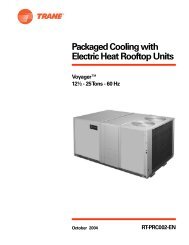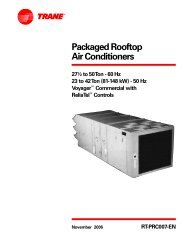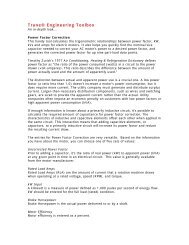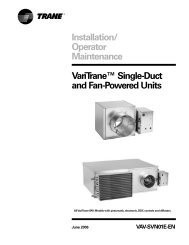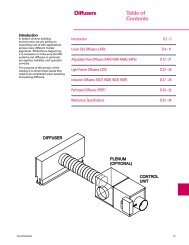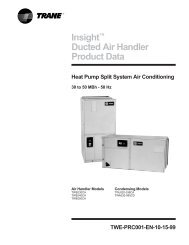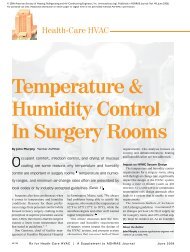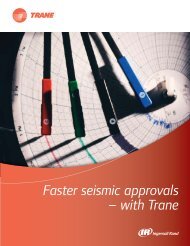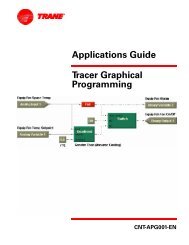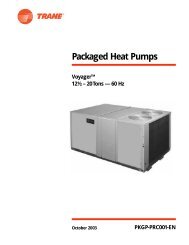RTHD and RTAC - Trane
RTHD and RTAC - Trane
RTHD and RTAC - Trane
Create successful ePaper yourself
Turn your PDF publications into a flip-book with our unique Google optimized e-Paper software.
Compressor Capacity - <strong>RTAC</strong><br />
Checkout Procedure for the Female Step Load Outputs<br />
� WARNING<br />
Live Electrical<br />
Components!<br />
A dual triac LLID (1U17, 2U17,) controls the female solenoid valve on the<br />
compressor with a 115VAC relay output. Refer to the wiring diagrams in the<br />
control panel for the following procedure.<br />
During installation, testing, servicing <strong>and</strong> troubleshooting of this product, it may<br />
be necessary to work with live electrical components. Have a qualified licensed<br />
electrician or other individual who has been properly trained in h<strong>and</strong>ling live<br />
electrical components perform these tasks. Failure to follow all electrical safety<br />
precautions when exposed to live electrical components could result in death or<br />
serious injury.<br />
With a particular compressor running, the relay may be checked (under load) by<br />
measuring the voltage for terminal J2-1 or J3-1 to neutral. The relay operators in<br />
the high side <strong>and</strong> switches power to J2-1 <strong>and</strong>/or J3-1, to move the female step<br />
load valve to the loaded position. When CH530 decides to load the compressor,<br />
the female step load is energized continuously. To assure that loading is<br />
occurring, it may be necessary to make slight adjustments to the chilled water<br />
setpoint to force the action.<br />
Checkout Procedure for the Step Load Solenoids Valve <strong>and</strong> Piston<br />
1 Connect a manifold gauge set to the schrader valve located at the side of the<br />
piston housing. Refer to Figure 33. This schrader allows access to the back<br />
side of the step load piston <strong>and</strong>, therefore, will allow direct measurement of<br />
the pressure that actuates the step load valve.<br />
2 Observe the pressure during a compressor start. Initially, the pressure should<br />
drop to suction pressure. The compressor will run unloaded for at least 45<br />
seconds.<br />
3 When the CH530 begins to load the compressor the solenoid will actuate <strong>and</strong><br />
supply discharge pressure to the piston.<br />
4 If after verifying the 115 VAC has been applied to the step load solenoid, the<br />
pressure does not increase to discharge pressure, the step load solenoid coil<br />
<strong>and</strong>/or the valve must be replaced.<br />
The percent RLA of the compressor should increase. If the percent RLA does<br />
not increase, the step load valve is stuck <strong>and</strong> compressor should be replaced.<br />
Note: All limits <strong>and</strong> safeties are still active. If the chiller enters into a condenser,<br />
current, or evaporator limit. Continuously monitor the operating mode.<br />
Checkout Procedure for the Male Load-Unload Outputs<br />
A dual triac LLID (1U16, 1U21,2U16, 2U21) controls the load <strong>and</strong> unload solenoid<br />
valve on the compressor with a 115VAC triacs (solid state relays). Unlike<br />
mechanical relays however, a triac has a rather high leakage current when off,<br />
comparatively speaking. While the leakage is not nearly enough to actuate a<br />
solenoid valve, it may under a no load condition (as would be experienced when<br />
a solenoid coil fails open), look like it was stuck “on” when using a voltmeter to<br />
RLC-SVD05A-EN 49



